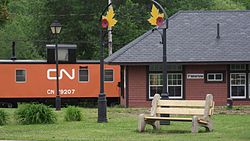Minto, New Brunswick
| Minto | |
|---|---|
| Village | |

Minto Museum and Veterans Park 2013, Minto, New Brunswick
|
|
| Location of Minto within New Brunswick. | |
| Coordinates: 46°08′59″N 66°06′24″W / 46.14972°N 66.10667°WCoordinates: 46°08′59″N 66°06′24″W / 46.14972°N 66.10667°W | |
| Country |
|
| Province |
|
| County | Queens County |
| Parish | Canning Parish |
| Incorporated | 1904 |
| Named for | Gilbert Kynynmound |
| Government | |
| • Type | Municipal council |
| • Mayor | Donald Gould |
| Population (2011) | |
| • Total | 2,505 |
| Time zone | Atlantic (AST) (UTC−4) |
| • Summer (DST) | Atlantic Daylight Time (ADT) (UTC−3) |
| Canadian Postal code | xxx |
| Area code(s) | 506 |
|
|
|
Minto (2011 pop. 2,505) is a Canadian village straddling the border of Sunbury County and Queens County, New Brunswick. Located on the north shore of Grand Lake, approximately 50 kilometres northeast of Fredericton, its population meets the requirements for "town" status under the Municipalities Act of the Province of New Brunswick, however the community has not made any change in municipal status.
Minto was originally named Northfield but it is known to have taken its present name in 1904 upon the retirement of Canada's eighth Governor General, The Earl of Minto. However, the village was known as Minto since 1902, and the story remains that the village adopted its name from the local Minto Hotel. From the St. John Daily Sun of 1903:
"Just how the name of Minto came to be adopted is said to have occurred in this way. A letter which was sent from Moncton to Mr. Kennedy was enclosed in an envelope which bore the name of the Minto hotel, Moncton. The family thought Minto a good name for their hotel, and so it was named. Then the people generally adopted the name for the place, and so the railway people designated it."
Minto did not feel the depression, or at least did not feel it in the same way as most other places in Canada; during recession and the Great Depression, Minto was profiting from a coal mining boom. The coal brought a level of financial prosperity to the community in the early 1900s, which by the late 1930s turned into a profitable venture for companies, and brought starvation and disease to a then impoverished community. As stated in the United Mine Workers' Journal of 1937, "Nowhere on the American continent, is there a strife which combines the elements of greed, harshness, cold, suffering, and want, as exists [in Minto]."
Early in Minto's coal mining exploits, land owners were permitted to mine under their own land without obtaining a license from the Crown or paying any royalties, which ended in 1915. During the boom, both mining conditions and the living quarters of miners families degraded with lowering wages and lack of maintenance in the mines and homes supplied to the miners families. Although a tally of the number of deaths related to the coal mining industry in Minto is not available, deaths did occur.
...
Wikipedia

